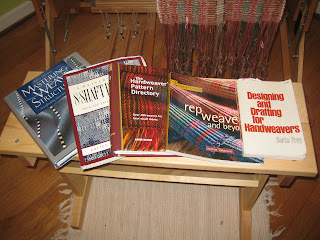Books

After receiving a few questions about where my patterns come from, I've decided that I really should have been citing the books that inspire me. So here is a list of the weaving books in my library. I also plan to go back and add book credits to my old posts where they are due.
Mastering Weave Structures: Transforming Ideas into Great Cloth, by Sharon Alderman
This is a great book, especially for beginners. I don't usually take patterns from it, because it isn't really a pattern book. But it does provide a lot of really great information about the kinds of weave structures out there. Each chapter focuses on a different weave stucture: Plain weave, twills, satin, waffle weaves, and on and on. And I really like the chapter on inventing your own weave structures.
A Weaver's Book of 8-Shaft Patterns from the Friends of Handwoven, edited by Carol Strickler
This is the book I go to most often when I am looking for ideas. I do pull many patterns directly from the pages of this one. I can open to any page and think "man, I want to try that!" I do have to admit that there are entire chapters that I don't understand and that sometimes the patterns call for a level of complexity that even my Mighty Wolf loom can't achieve. If I ever take another weaving class, I think I'll bring this book with me and just start pointing to things and asking questions.
The Handweaver's Pattern Directory: Over 600 Weaves for Four-Shaft Looms, by Anne Dixon
Again, a great pattern book. This one is in full color. It is extremely easy to understand and is spiral bound, which can be very helpful when your trying to work and understand something at the same time. Personally, I think every weaver should own this book or one like it. Sometimes, when I am browsing through it, I am astonished at how much you can do with just four shafts. It's a wonder that I ever use all 8 that I have.
Rep Weave and Beyond, by Joanne Tallarovic
The two rep weave projects that I have done came from this book, although I altered them both a bit. While rep weave is covered in all of the other books I've mentioned, I was never able to make sense of it until I bought this book. The two things that I don't really like about this one are that 1. she weaves all of her rep weaves with fabric wefts, and I don't really like that look. I always substitute a really thick cotton. And 2. she spaces her ends per inch too wide for my taste, so I always bring it in to make a denser warp. But this could be a function of the fact that she uses a fabric weft which looks nice with a wider epi. If you are interested in learning rep weave, I do recommend this one.
And finally, a tiny little book from 1958:
Designing and Drafting for Handweavers, by Berta Frey
I wish that I could say that I've read all of this book and done all the exercises. But I have not. I really want to get better at designing my own weave structures, but there is a wall of complexity that I hit every time I try. And I find the computer software endlessly confusing. So I bought this book, which feels like a text book: you need to read it carefully and then do all the exercises. But, because it is hard work to get through, I have not completed very much of it.


I love your choice of books and must admit that they are all in my library too! Although I must admit that I never seem to have enough weaving books....go figure?
ReplyDeleteI have just ordered the Handweavers Pattern Directory and the Mastering Weave structures books, thanks for advising good books, it is much appreciated. Good luck with the exam.
ReplyDeleteGryph